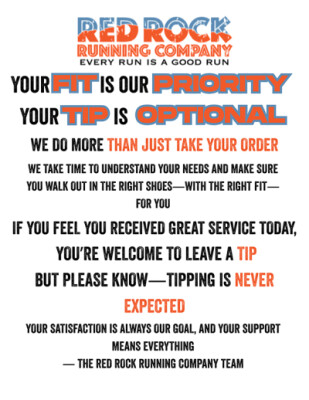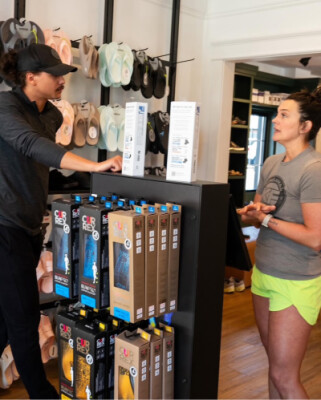On July 12, run specialty retailer Mark Jimenez took to Instagram and the Red Rock Running Company blog with an announcement. “We’re now accepting tips at Red Rock Running Company,” Jimenez began. “Our team goes above and beyond every day – and if you feel moved to show your appreciation, tips are now welcome, but never expected.”
The owner of Las Vegas-based Red Rock since 2018, Jimenez didn’t come to the decision lightly, nor without significant reflection.
While he offers staff at his four stores competitive pay in addition to medical, dental, vision and a 401K match, Jimenez says he’s always looking to improve staff members’ quality of life. Tipping, a familiar piece of Las Vegas’ service-driven landscape, presented an opportunity to bolster staff pay and help employees see the value of their work, potentially sparking a deeper commitment to run specialty as a career.
At the same time, however, Jimenez acknowledged in his blog post that tipping culture had “swung too far” in the post-pandemic era. Even though Red Rock customers had occasionally asked staff if they accepted tips, Jimenez was nevertheless concerned about backlash from customers. He fretted about associates pushing for a tip and giving the entire Red Rock operation “a black eye.”
Ultimately, though, Jimenez elected to “test the waters” at Red Rock – albeit carefully.
In addition to explaining his rationale on Red Rock’s digital channels, he posted a sign at each store’s cash wrap reading, in part: “If you feel you received great service today, you're welcome to leave a tip. But please know – tipping is never expected.”
“We wanted to create as stress-free a tip environment as possible,” he says.
An ongoing debate
To be certain, tipping has emerged an increasingly hot cultural topic over recent years, spurring sometimes intense debate on both sides of the coin.
While tipping retail workers is undoubtedly a newer phenomenon, it is not without its merits and its fans. Last year, point-of-sale commerce platform Lightspeed surveyed more than 2500 consumers across the U.S. and Canada and found 69 percent of Americans were willing to tip retail staff who provided a memorable shopping experience. Among Gen Z (ages 18-24), the number soared to 89 percent.
"A decade ago, you didn't see tipping in retail and now that's become much more prevalent and the willingness is there if the service is there," Lightspeed CEO Dax Dasilva told USA Today last November.
While Dasilva called retail tipping “uncharted waters,” etiquette expert Elaine Swann expressed her discontent with the trend. She called tipping for exceptional service a nice gesture, but she advised retailers against “going down this path.” Compensation, she argued, should be the responsibility of companies, not something transferred onto consumers.
“Retailers should have strict policies that say: 'Please do not tip our folks. We take good care of them ourselves,’” Swann told USA Today.
At Run Fit Sports, a 21-year-old business with three locations in central Georgia, CEO Perry Slaughter says accepting tips “isn’t a road I want to go down.”
“There are small things that irritate everyone on some level. Tipping is one of those things,” Slaughter says. “Being pressured, even if it is subtle, to leave a tip can dissuade a customer from every returning to your store.”
Slaughter calls buying an “emotional” experience and says he’d rather a customer’s emotion be tied to appreciation for staff’s attentiveness and knowledge rather than being nudged to leave a tip at the end of their in-store experience. It’s not worth it, he says, for staff to earn an extra $3 on a $100 purchase if it irritates a customer.
“Running store owners should always take a step back and put themselves in the customers' shoes,” Slaughter says. “If it is something that would offend you, even in the slightest, do not do it to your customers.”
The benefits and challenges
At Runaround Running & Lifestyle in Joplin, MO, owner Erik Bartlett began accepting tips last summer, largely to highlight Runaround’s high level of service as a differentiator.
“I didn’t have much question if our staff would’ve earned the tip because we work hard at our craft here,” Bartlett says of the team at his 15-year-old store. “The bigger concern was how we’d present it to the customer.”
Like Red Rock, Bartlett installed a sign at the register explaining tips were accepted. Initially, customers needed to verbalize their desire to leave a tip; more recently, though, Bartlett added the tip option to his credit card reader to give the customer control and choice, including the ability to discretely decline a tip.
“We haven’t experienced a negative yet,” Bartlett says, adding that some staff are now earning double their hourly rate and customers have even expressed appreciation for having a tip option available. “Honestly, I wonder why we weren’t doing this sooner. When people realize they’re getting a level of service they can’t get anywhere else, they appreciate it.”

Jimenez says Red Rock’s three-month run with tips has been “successful but not without its bumps” and tweaks.
While the cash wrap signage remains, Jimenez, too, has added a tip option to his stores’ credit card reader. Customers can select tip rates of one, three or five percent as well as a custom amount. If a customer comes in and grabs socks off the wall or a few energy gels, instances in which staff did not provide direct, extensive service, Jimenez has instructed team members to proactively hit the screen’s “no tip” button during check out.
“We want to reserve this solely for the people who go through our fit process and experience our service,” he says, noting that Red Rock staff collectively captured an average of $6000 in tips each pay period over the program’s first six weeks.
Red Rock did receive a one-star review on one online platform specifically citing the tip screen. (Interestingly, the customer noted she “would like to give this place five stars and I probably would for the service.”)
“I get the point of view I can’t make everyone happy,” Jimenez allows, acknowledging he might have more liberty to trial tipping in Las Vegas given the size of the market and the area’s robust service industry workforce. “We’ll continue to evaluate this and how it works for our staff and our customers.”







